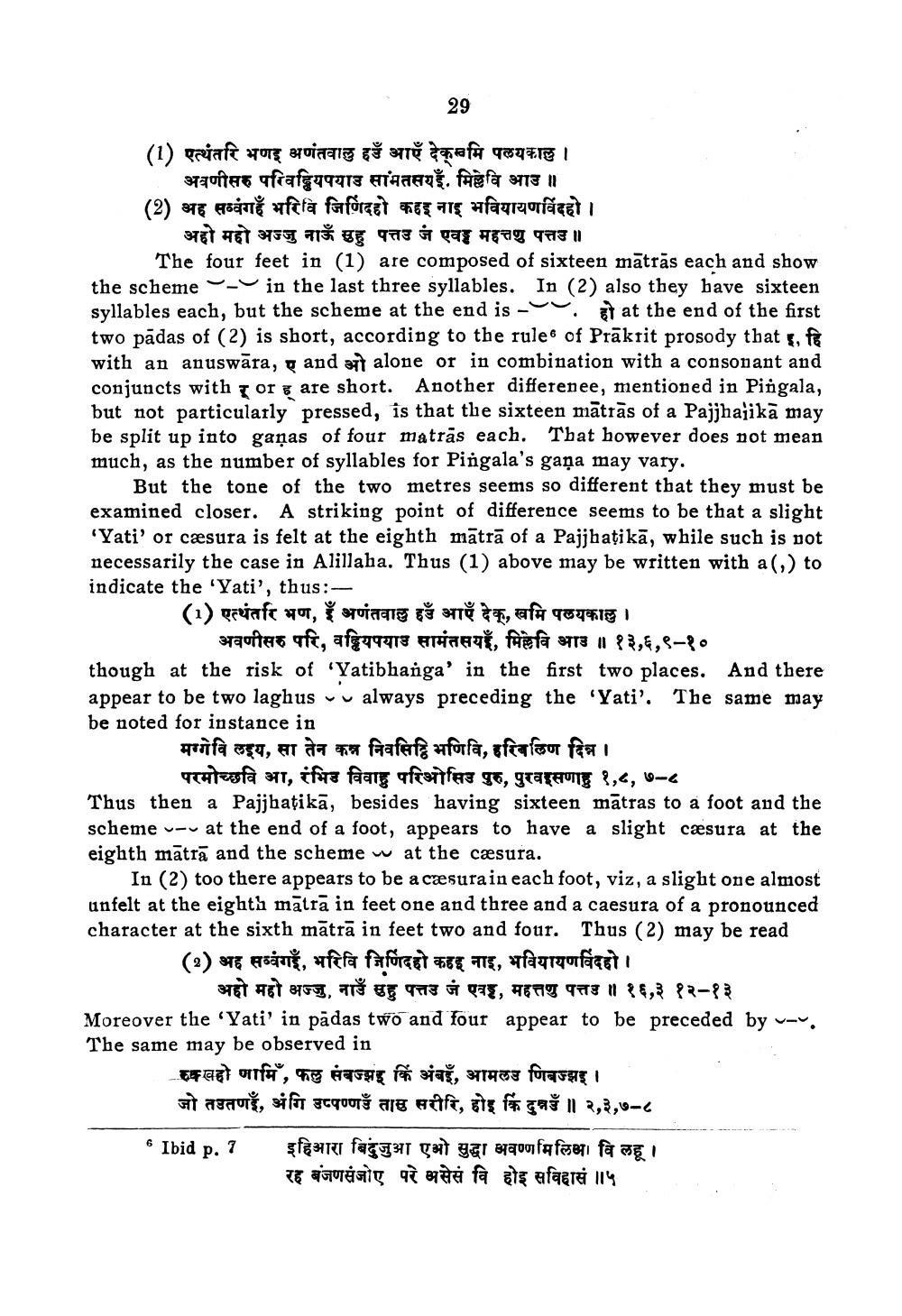________________
29
(1) एत्थंतरि भणइ अणंतवाल हउँ आएँ देवस्वमि पलयकाल ।
अवणीसह परिवद्वियपयाउ सांमतसय ई. मिल्लेवि आउ॥ (2) अह सव्वंगहँ भरिवि जिणिदहो कहइ नाइ भवियायणविंदहो।
अहो महो अज्जु नाऊँ मुह पत्तउ जं एवड महत्तणु पत्तउ॥
The four feet in (1) are composed of sixteen mātrās each and show the scheme~-~in the last three syllables. In (2) also they have sixteen syllables each, but the scheme at the end is - हो at the end of the first two padas of (2) is short, according to the rules of Prakrit prosody that s, हि with an anuswāra, y and at alone or in combination with a consonant and conjuncts with or are short. Another differenee, mentioned in Pingala, but not particularly pressed, is that the sixteen mātrās of a Pajjhajikā may be split up into gaņas of four matras each. That however does not mean much, as the number of syllables for Pingala's gaña may vary.
But the tone of the two metres seems so different that they must be examined closer. A striking point of difference seems to be that a slight
Yati' or cæsura is felt at the eighth mātrā of a Pajjbaţikā, while such is pot necessarily the case in Alillaha. Thus (1) above may be written with a(,) to indicate the 'Yati', thus:--
(1) एत्वंतरि भण, हूँ अणंतवाल हउँ आएँ देक्, खमि पलयकाल ।
___अवणीसह परि, ववियपयाउ सामंतसयर, मिल्लेवि आउ ॥ १३,६,९-१० though at the risk of 'Yatibhanga' in the first two places. And there appear to be two laghus vu always preceding the 'Yati'. The same may be noted for instance in
मग्गेवि लइय, सा तेन कन निवसिहि भणिवि, हरिवलिण दिन्न ।
परमोच्छवि आ, रंभिड विवाह परिओसिउ पुरु, पुरवइसणाह १,८,७-८ Thus then a Pajjbaţikā, besides having sixteen matras to a foot and the scheme v-v at the end of a foot, appears to have a slight cæsura at the eighth mātrā and the scheme w at the cæsura.
In (2) too there appears to be a cæsurain each foot, viz, a slight one almost unfelt at the eighth mātra in feet one and three and a caesura of a pronounced character at the sixth mātrā in feet two and four. Thus (2) may be read
(8) अह सव्वंगइँ, भरिवि जिणिदहो कहइ नाइ, भवियायणविंदहो।
अहो महो अज्जु, नाउँ सहु पत्तउ जं एवड्ड, महत्तणु पत्तउ ॥ १६,३ १२-१३ Moreover the 'Yati' in pādas two and four appear to be preceded by v-v. The same may be observed in
रुक्खहो जामि, फल्ल संबज्झइ किं अंबइँ, आमलउ णिबज्झइ । जो तउतण, अंगि उप्पण्णउँ तासु सरीरि. होड दिनउँ॥ २.३.७-
6 Ibid p. 7
इहिआरा बिदुजुआ एओ सुद्धा अवण्णमिलिभा वि लह। रह बंजणसंजोए परे असेसं वि होइ सविदासं ॥५




